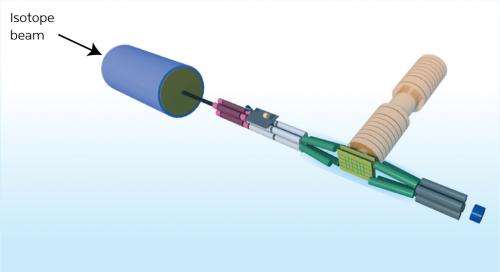Exotic isotopes step on the scale

Elements heavier than iron are believed to have formed in supernovae or merging neutron stars through a series of complex nuclear reactions. Nuclear physicists are working to recreate these reactions by performing simulations, but such studies rely on highly precise masses for the relevant isotopes—many of which can only be created using high-energy accelerators. Michiharu Wada and colleagues from the RIKEN Nishina Center for Accelerator-Based Science in Wako have now demonstrated the utility of a new mass spectrograph at the Radioactive Isotope Beam Factory (RIBF) for measuring the masses of short-lived exotic isotopes.
Wada and colleagues built what is called a multi-reflection time-of-flight mass spectrograph (Fig. 1), which captures isotopes produced by the RIBF and slows them to a well-defined kinetic energy before measuring the ratio of their mass to charge based on the time it takes to travel a known distance.
As the precision of the measurement improves the longer the distance travelled by the isotope, the researchers created a long, yet compact, trap by introducing electric-field 'mirrors' on either end to force the isotopes to bounce back and forth. Isotopes make several hundred roundtrips before they are released to a detector that registers the time elapsed in the trap.
In their first test, Wada and his team successfully measured the mass of singly ionized lithium-8 with an uncertainty of only 0.66 parts per million over a time-of-flight time of just 8 milliseconds. This isotope serves as a worst-case scenario for the spectrograph, which is optimized to study heavier isotopes with half-lives of 10–100 milliseconds.
In addition to studying short-lived isotopes relevant to astrophysical processes, the team plans to use the spectrograph to study isotopes heavier than uranium at the RIBF's gas-filled recoil ion separator (GARIS) facility. "Precise and systematic mass measurements of these isotopes are an important prerequisite for exploring the 'island of stability', which is predicted to lie beyond the known super-heavy elements," says Wada.
One of the key advantages of installing the new mass spectrograph at the RIBF is the fact that it can be used to measure nuclei that can't be created anywhere else in the world. "RIKEN's forthcoming slow radioactive nuclear ion beam facility, SLOWRI, will provide low-energy beams of all elements," says Wada. "The expected number of nuclides that will be available is the largest among existing radioactive isotope beam facilities in the world."
More information: Ito, Y., et al. Single-reference high-precision mass measurement with a multireflection time-of-flight mass spectrograph, Physical Review C 88, 011306(R) (2013). dx.doi.org/10.1103/PhysRevC.88.011306
Provided by RIKEN



















